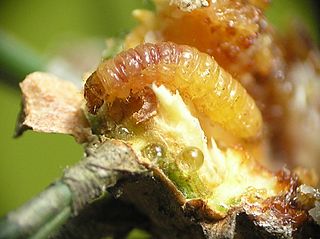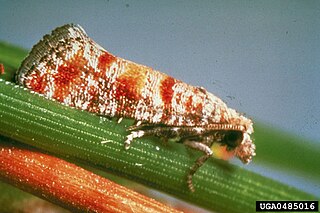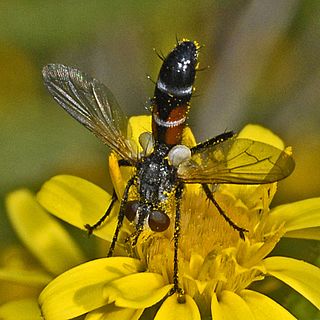
The Tortricidae are a family of moths, commonly known as tortrix moths or leafroller moths, in the order Lepidoptera. This large family has over 11,000 species described, and is the sole member of the superfamily Tortricoidea, although the genus Heliocosma is sometimes placed within this superfamily. Many of these are economically important pests. Olethreutidae is a junior synonym. The typical resting posture is with the wings folded back, producing a rather rounded profile.

Archips oporana, also known as the pine tortrix or spruce tortrix is a moth of the family Tortricidae, found in Asia and Europe. It was first described by Carl Linnaeus in 1758.

Protodeltote pygarga, the marbled white spot, is a species of moth of the family Noctuidae. It is found in the Palearctic realm.

Tachina fera is a species of fly in the genus Tachina of the family Tachinidae. It was first described by Carl Linnaeus in 1761.

Rhyacionia is a genus of moths belonging to the subfamily Olethreutinae of the family Tortricidae.

Ditula angustiorana, the red-barred tortrix, is a moth of the family Tortricidae found in Africa, Asia, Europe and North Africa. Other common names are the fruit-tree tortrix and the vine tortrix. The moth was first described by Adrian Hardy Haworth in 1811.

Retinia resinella, the pine resin-gall moth, is a moth of the family Tortricidae.

Rhyacionia duplana, the summer shoot moth or Elgin shoot moth when referring to subspecies logaea, is a moth of the family Tortricidae. It is found from northern and central Europe to eastern Russia, China and Japan. It has also been reported from Korea, but it has not been found in recent studies.

Rhyacionia pinicolana is a moth of the family Tortricidae. It is found from northern and central Europe to eastern Russia, China, Japan and Korea.

Rhyacionia pinivorana, the spotted shoot moth, is a moth of the family Tortricidae. It is found from northern and central Europe to eastern Russia, China, Korea and Japan.

Rhyacionia frustrana, the Nantucket pine tip moth, is a moth of the family Tortricidae. It is found in the United States from Massachusetts south to Florida, west to Missouri, Oklahoma, Texas and California. It is also found in the Dominican Republic, Cuba, Jamaica, Mexico (Oaxaca), Guatemala, Honduras and Nicaragua.

Rhyacionia bushnelli, the western pine tip moth, is a moth of the family Tortricidae. It is found in the United States, including Alabama, Nebraska, North Dakota and Montana.

Rhyacionia subtropica, the subtropical pine tip moth, is a species of moth of the family Tortricidae. It is found in the United States in southern Alabama and Florida. It has also been recorded from Cuba and Belize.

Rhyacionia hafneri is a species of moth of the family Tortricidae. It is found in the Czech Republic, Hungary, Croatia, Bulgaria and Slovenia.

Cylindromyia interrupta is a species of fly in the family Tachinidae.
Actia nudibasis is a Palearctic species of flies in the family Tachinidae.
Rhyacionia dativa is a species of moth of the family Tortricidae. It is found in China, Taiwan, Korea, Japan and Russia.
Rhyacionia insulariana is a species of moth of the family Tortricidae. It is found in China.

Acantholyda erythrocephala is a species of sawfly in the family Pamphiliidae commonly known as the red-headed pine sawfly or the pine false webworm. Native to Europe, it has been introduced into North America where it has become invasive.

Rhyacionia logaea, the Elgin shoot moth, is a species of moth belonging to the family Tortricidae. It was previously considered a subspecies of Rhyacionia duplana, the summer shoot moth. It is now considered the sister species of R. duplana.




















